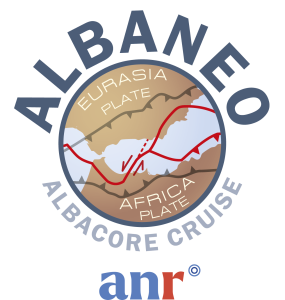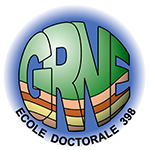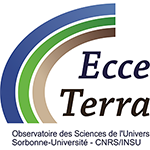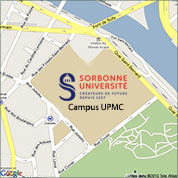2024 CDD ALBANEO Sédimentologie

post-doc conjoint entre l'ISTEP et GEO-OCEAN
Type de contrat : CDD Post-doctorat
Employeur : Sorbonne Université
Date de début prévue : 1er Juin 2024 (10 mois, probablement prolongeable)
Candidatures ouvertes jusqu'au 15 avril 2024
Le ou la candidat.e, avec un profil recherché de sédimentologue, travaillera sur les données de la campagne ALBACORE (sud Alboran), dans le cadre de l'ANR ALBANEO
plus de précisions en anglais ci-dessous
Contact : christian.gorini @ sorbonne-universite.fr
sara.lafuerza @ sorbonne-universite.fr and elia.dacremont @ sorbonne-universite.fr
***
CDD Postdoctorate in sedimentology - ALBANEO Project
Type of contract : CDD
Status : Post-doctorate
Employer : Sorbonne University
Duration : 10 months possibly extendable
Location
The Institut des Sciences de la Terre de Paris (ISTeP, Paris Institute of Earth Sciences) is a multi-disciplinary laboratory with recognized expertise in many and varied areas of the geosciences. The main disciplines supported by ISTeP and around which the laboratory is structured are (1) petrology (metamorphic and magmatic) in relation to geodynamic contexts, notably subduction, (2) the dynamics, and the structural and sedimentary link of margins and oceans, considering paleoclimatic and paleoenvironmental archives and (3) tectonics, with the study of lithospheric deformation and rheology on variable temporal and spatial scales, from the seismic cycle scale of a fault to the long- term crustal deformation in orogens. The laboratory is also structured around cross-disciplinary themes: hazards (seismic, volcanic, gravity), transition (new energies - geothermal, natural hydrogen, resources (Li), materials), as well as a common project, the Mediterranean Sea.
The post-doctoral fellow would join ISTeP's ‘Terre Mer’ team and the scientific team of the ALBANEO project. A part of this work will be conducted at the GeoOcean laboratory in Brest in collaboration with Pascal Leroy and the Astre research team. Our partner Geo Ocean Laboratory is also multi-disciplinary with research topics focusing on mechanical couplings, chemical exchanges, transfers between solid Earth interfaces and surface envelopes, dynamic processes underlying geological hazards and coastal risks, as well as sedimentary records of these various processes. To carry out cutting-edge research in these fields, its team explore new methods of observation, sampling, and analysis methods, as well as the implementation of instrumentation both at sea and in the laboratory.
Study background
The ALBANEO project, which is funding this CDD, focuses on the dynamics of an intracontinental fault system along an incipient plate boundary in the Alboran Sea, and its implication for continental shelf morphology, regional seismic and tsunami hazards. Project partners include Sorbonne University (ISTeP), Géoazur (Sophia-Antipolis), UMR Geo-Ocean (Brest), GEC (Cergy), ENS Paris, Linnaeus Univ. (Sweden), CSIC-ICM Barcelona, University of Granada, IEO Malaga. The ALBANEO project aims to enhance the value of the ALBACORE campaign data, in particular by enabling the coupled integration of geological and geophysical data.
Main tasks
The main objective of this study is to understand the forcing processes controlling the deposition and the preservation of the high frequency Quaternary sequences along the Mediterranean Moroccan continental shelf and to deconvolute the role of active tectonics, climate, sea level fluctuations and hydrodynamics involved in shelf margin development.
The tasks that need to be performed by the post-doctoral fellow include:
- -Specify the chrono-stratigraphic framework and timing of shelf margin deposits in relation to the high-frequency Quaternary sequences, detailing the architecture of deposits and hierarchical patterns in the stratigraphic record in relation to sea level changes and Holocene climatic variability. In particular, efforts will be made to date the formation of sedimentary waves recognized at the top of the Al Hoceima prodelta system. A palynological study will be included (in collaboration with J.P. Suc, Geobiostratdata Consulting) to understand, past vegetation and climatic fluctuations. Indeed, environmental changes are assumed to play a strong control on associated hydrodynamic conditions in prodeltaic systems. Stratigraphic calibration will also be facilitated by radiocarbon dating and analytical measurements of oxygen isotopes.
- -Analyse the internal geometry, sedimentary characteristics (nature), and mechanical properties of the sediment waves and dunes observed on the Al Hoceima continental shelf
- -Understand the forcing processes behind the formation of platform deposits with a focus on hydrodynamic processes. The research will aim to determine whether current hyperpycnal flows are capable of generating the observed sediment undulations and associated gullies or if they correspond to fossil structures. Additionally, exploring a possible relationship between glacio- eustatic cyclicity and the faulting activity will be investigated; Initial seismic interpretations suggest fault reactivation in connection with glacio-eustatic cycles, particularly during periods of low sea level. This hypothesis requires further analyses.
Available Data:
Geophysics: swath-bathymetry coverage, sub-bottom profiles, and high-resolution seismic reflection data. Sedimentary and geotechnical data: 5 piston cores (Calypso) through the shelf margin series and 5 in situ CPT (Cone Penetration Test). Previous geophysical data have been the subject of a thesis, providing an initial stratigraphic framework for the Quaternary series (Lafosse et al., 2018). Recent platform data have been used for an initial core description project (Master's thesis, Degoul 2022), which has provided material for dating (ongoing ARTEMIS program), palynological analyses (ongoing JP. Suc), and isotopic geochemistry (ongoing L. Emmanuel). Additional XRF (X-ray fluorescence) analyses are scheduled for February 2024.
Supervision: C. Gorini, P. Le Roy, in collaboration with S. Lafuerza, E d’Acremont, L. Emmanuel, JL Rubino and all the ISTEP and ANR ALBANEO team.
The candidate will carry out this work in connection with task 3 (Stratigraphic model of the Al- Hoceima shelf-slope prism with ages of major surfaces and paleo-environmental interpretation of facies) of the ANR ALBANEO, and the results of this work will be implemented in tasks 4 (Mechanical and kinematic modeling of strike-slip fault systems) and 5 (Project management, database implementation and dissemination of results).
Address : Campus Pierre et Marie Curie, Tour 46-0, 2ème Etage, 4 place Jussieu, 75005 PARIS
How to apply:
Planned starting date : 1/06/2024
Application deadline : 15/04/2024
Contact : christian.gorini @ sorbonne-universite.fr
sara.lafuerza @ sorbonne-universite.fr and elia.dacremont @ sorbonne-universite.fr
Egalement dans la rubrique
Chiffres clés (Mars 2025)
L'ISTeP comprend 131 membres dont :
Permanents (66)
- Professeurs : 17 (+2 PAST)
- Maîtres de conférence : 26
- Directeurs de recherche CNRS : 1
- Chargés de recherche CNRS : 1
- ITA : 19
Personnels non permanents (65)
- Collaborateurs bénévoles / émérites : 17
- Chaire de professeur junior : 1
- Enseignants-chercheurs contractuel : 2
- 1 MCF accueil en délégation
- ATER et Post-Docs : 9
- Doctorants : 32
- ITA-BIATSS : 3





